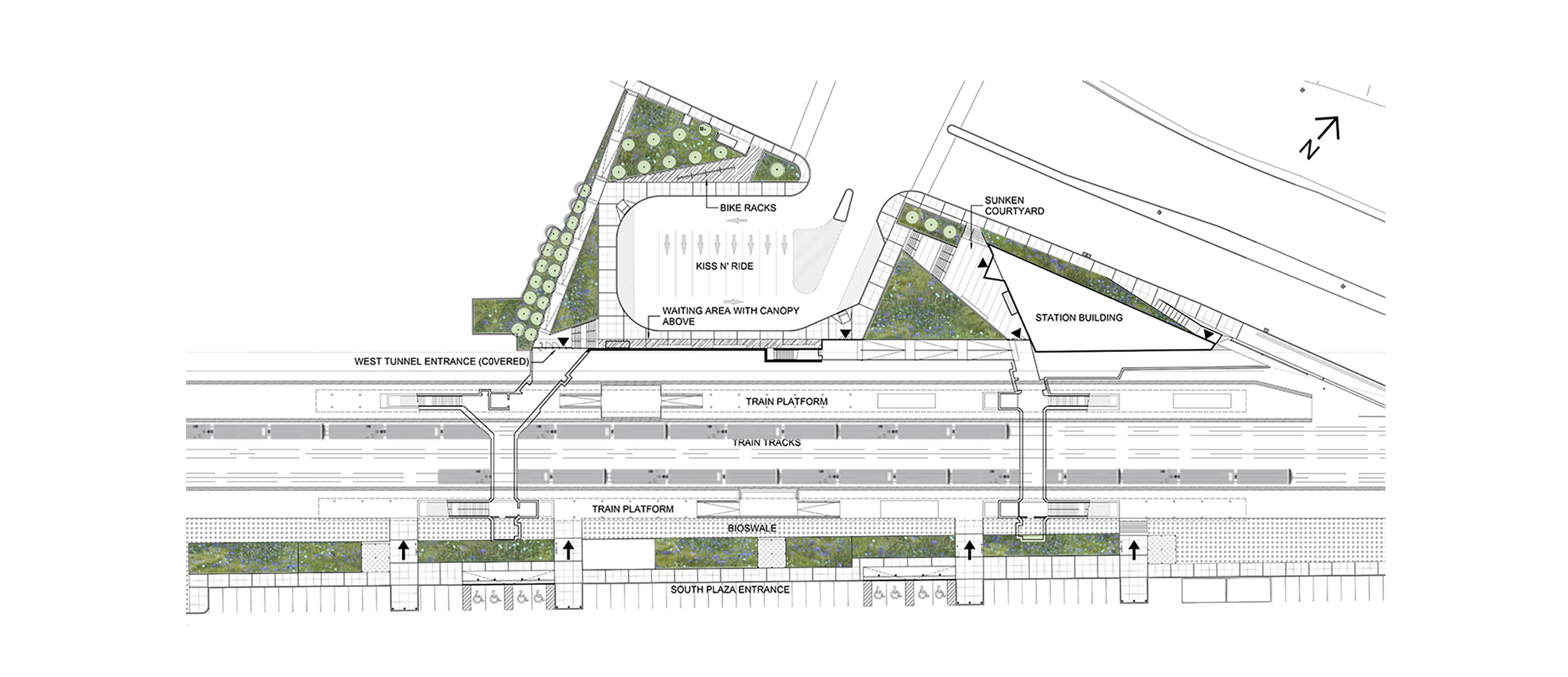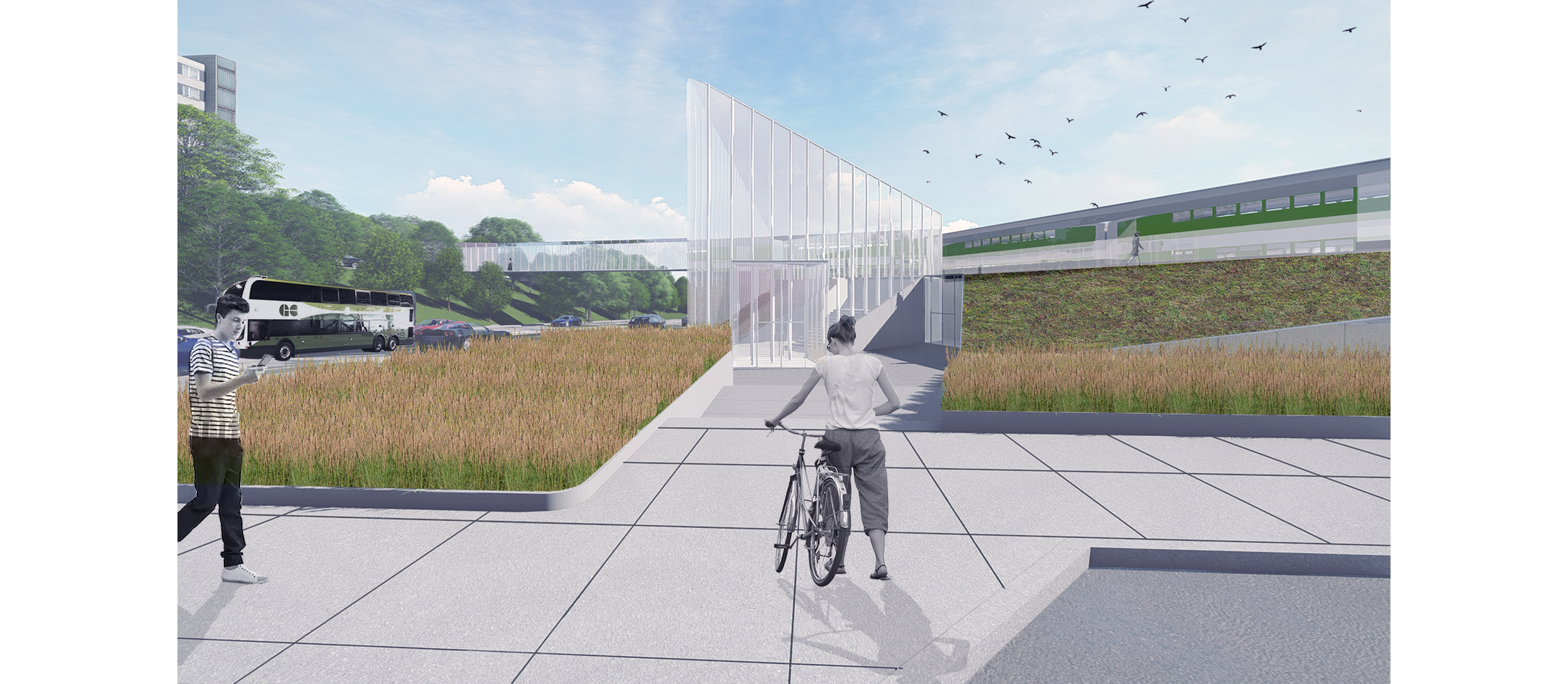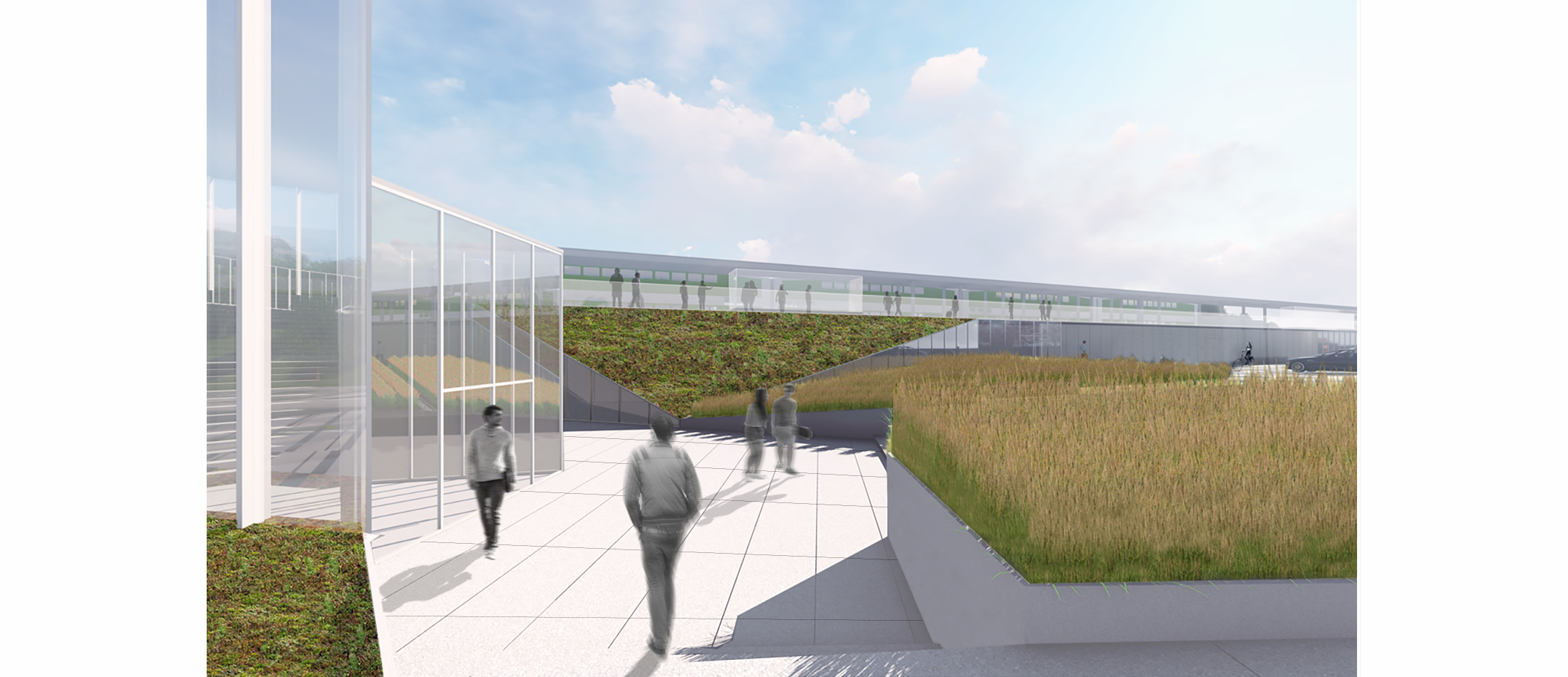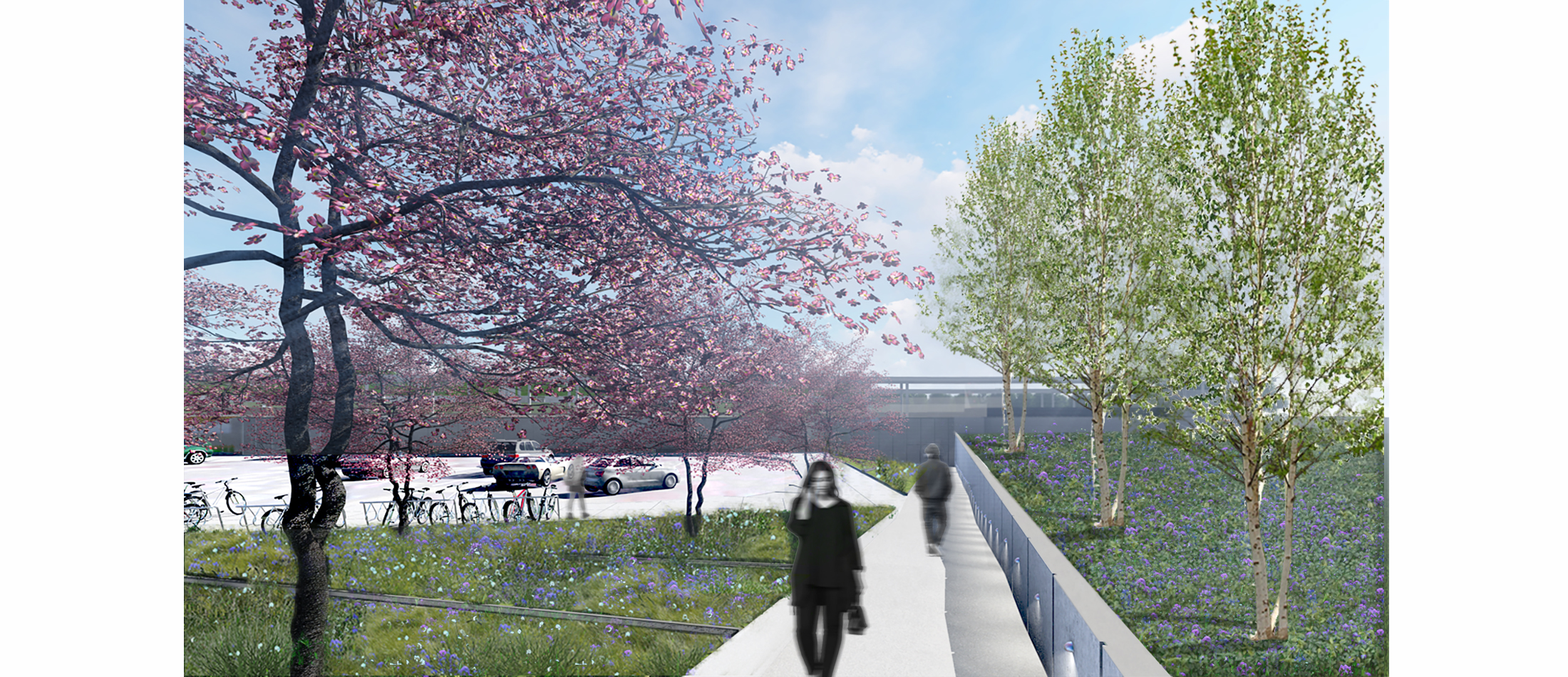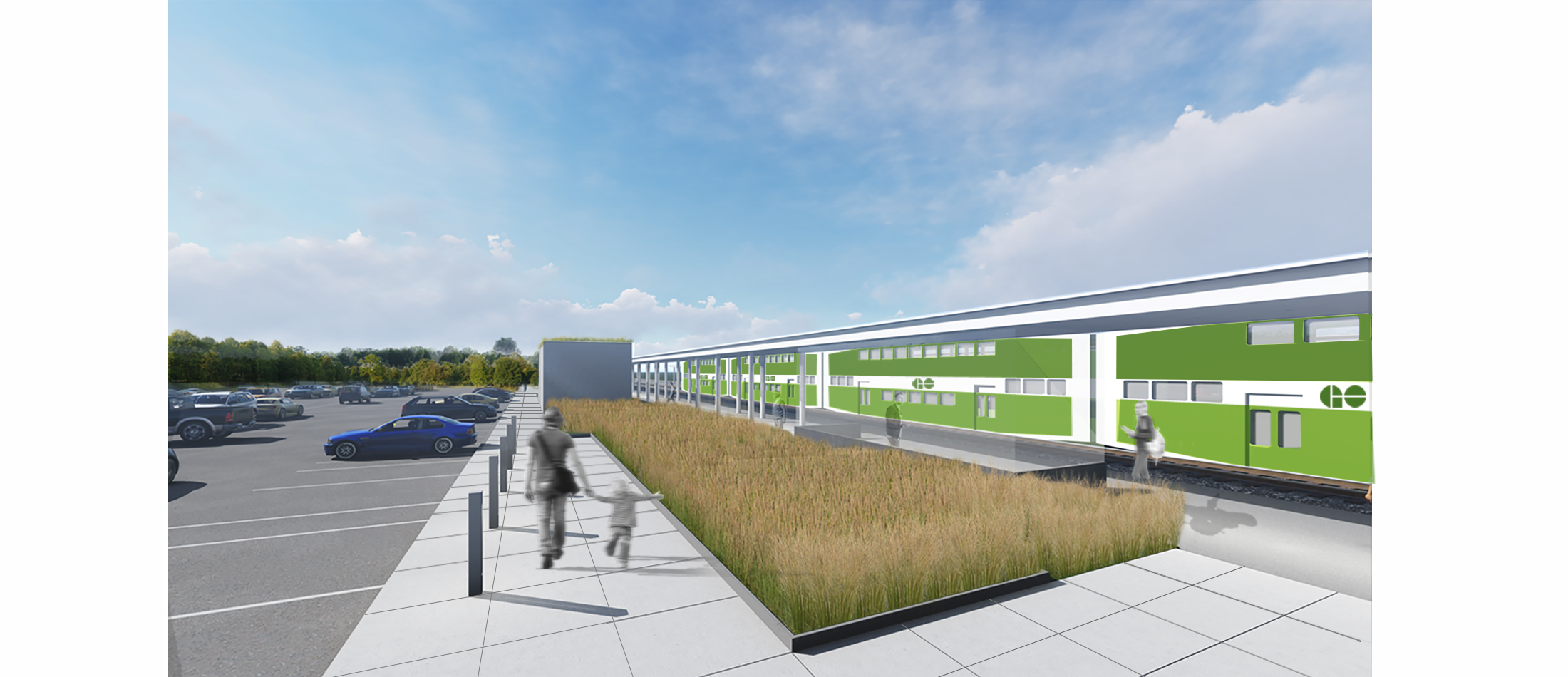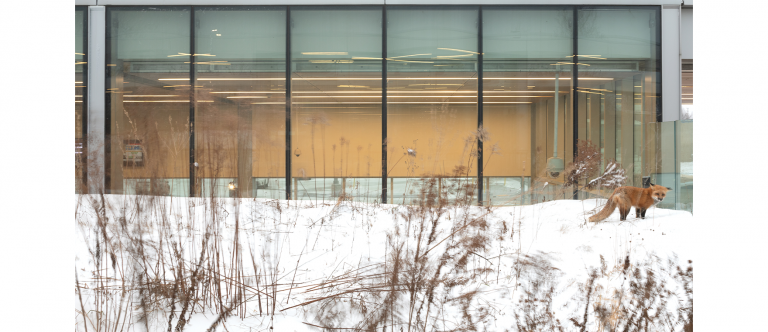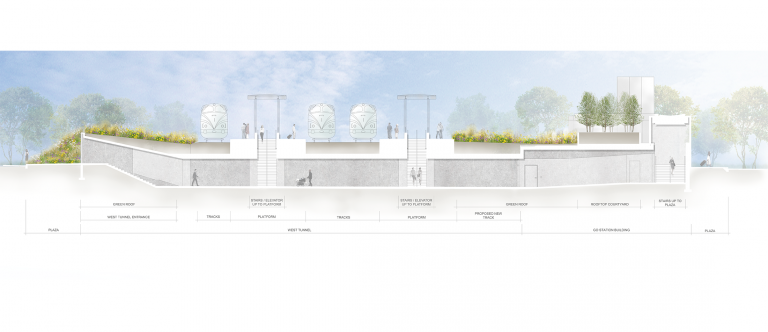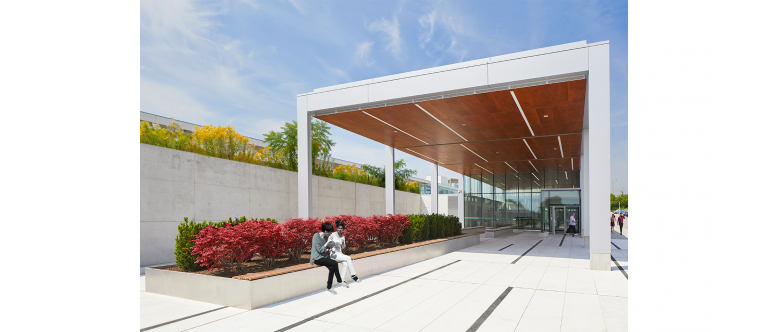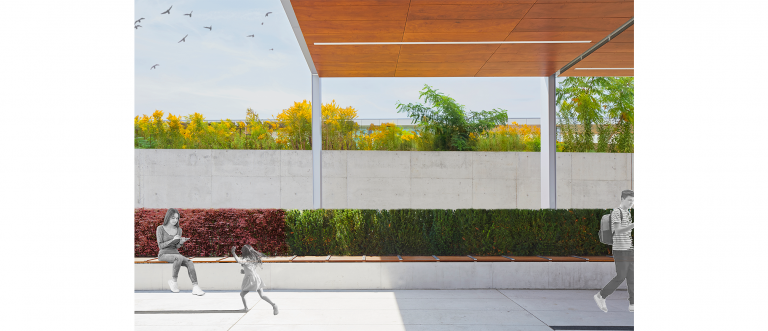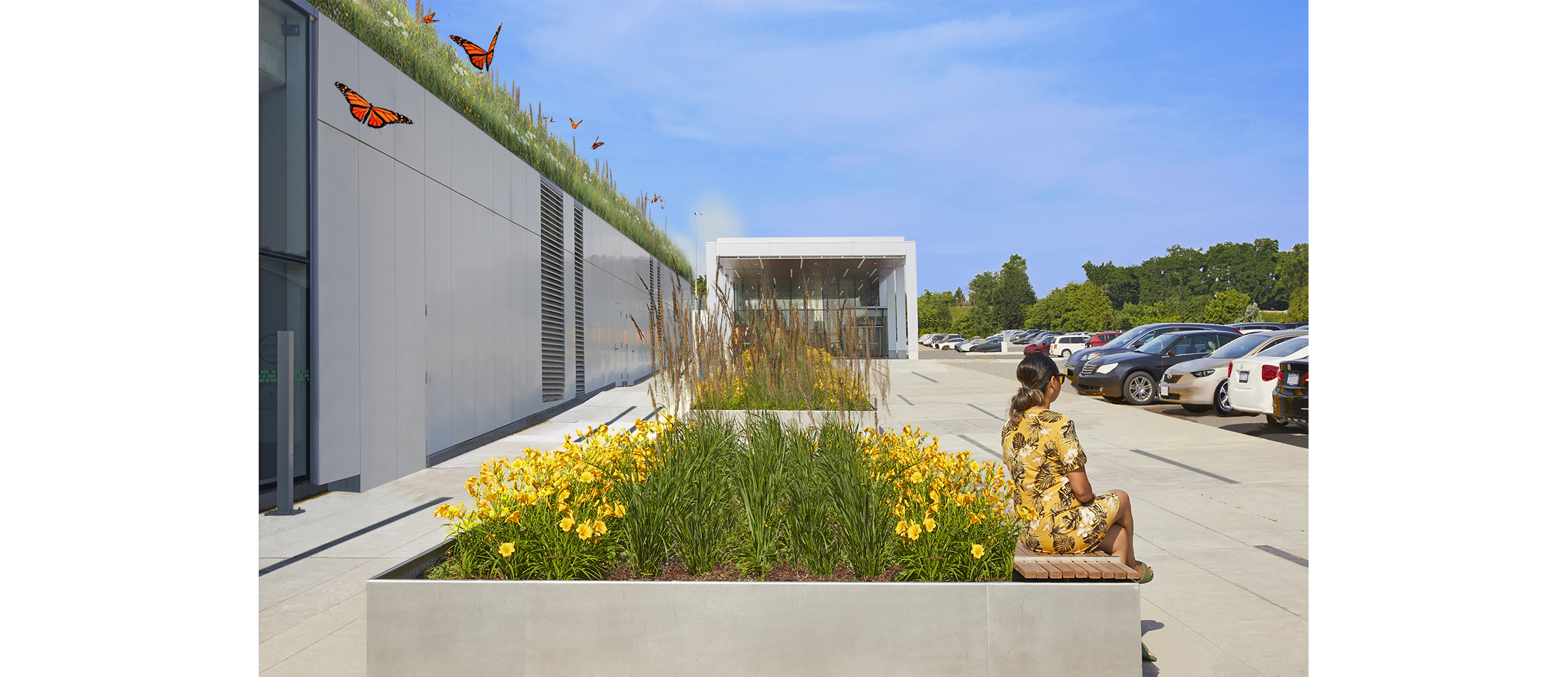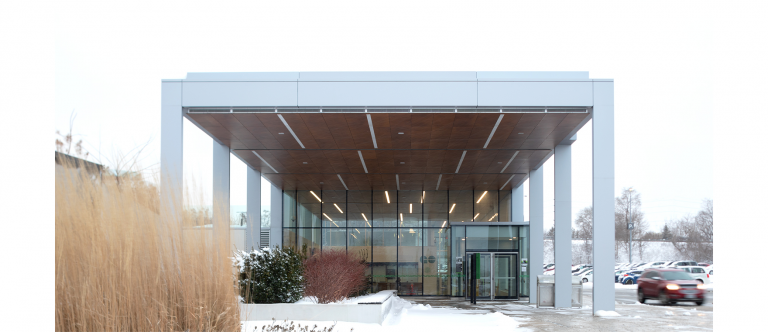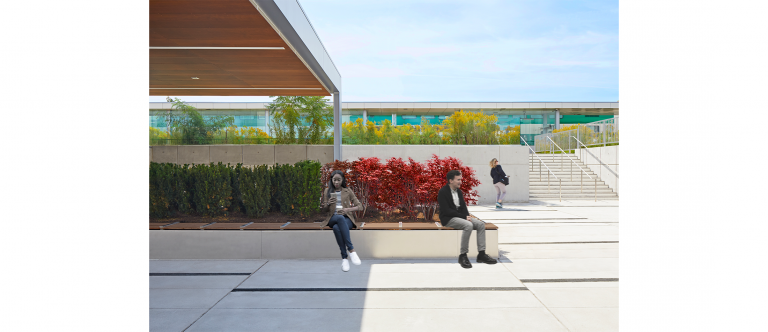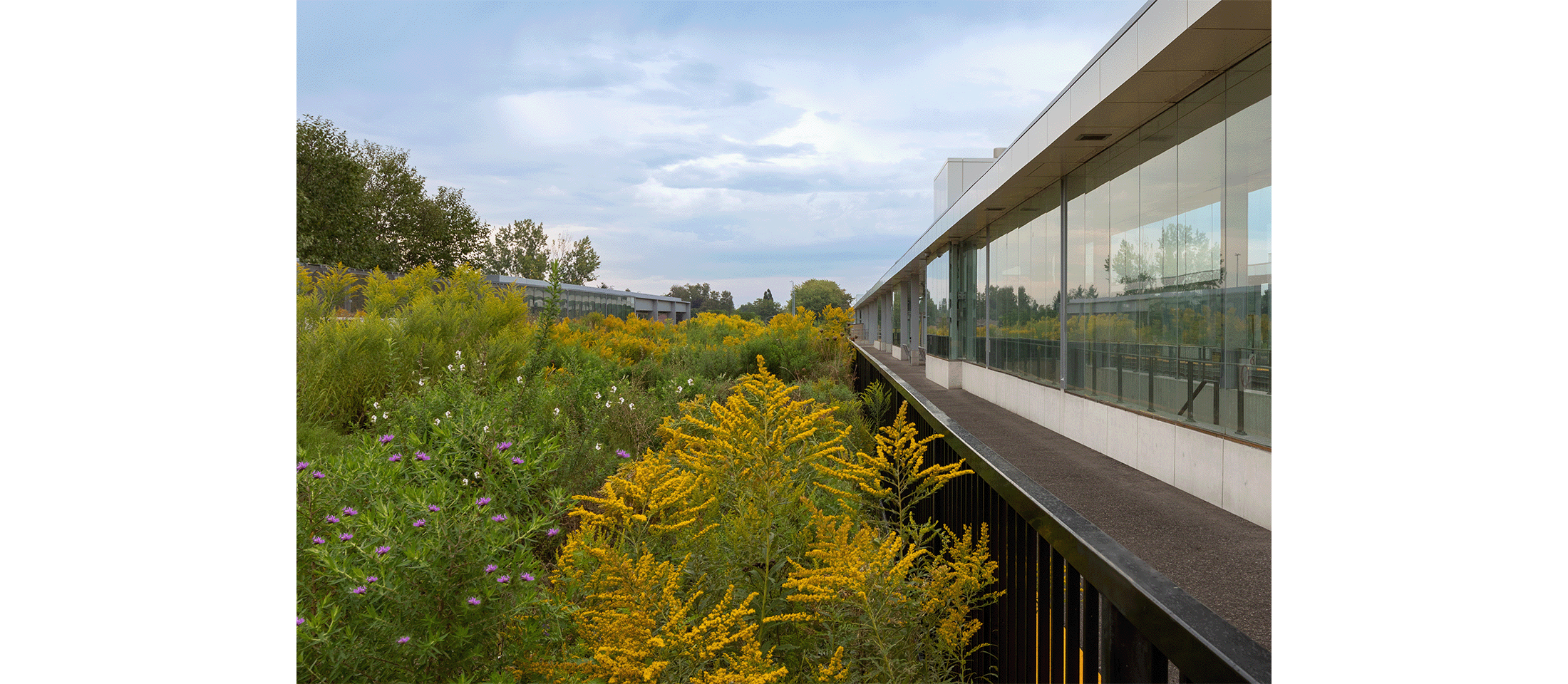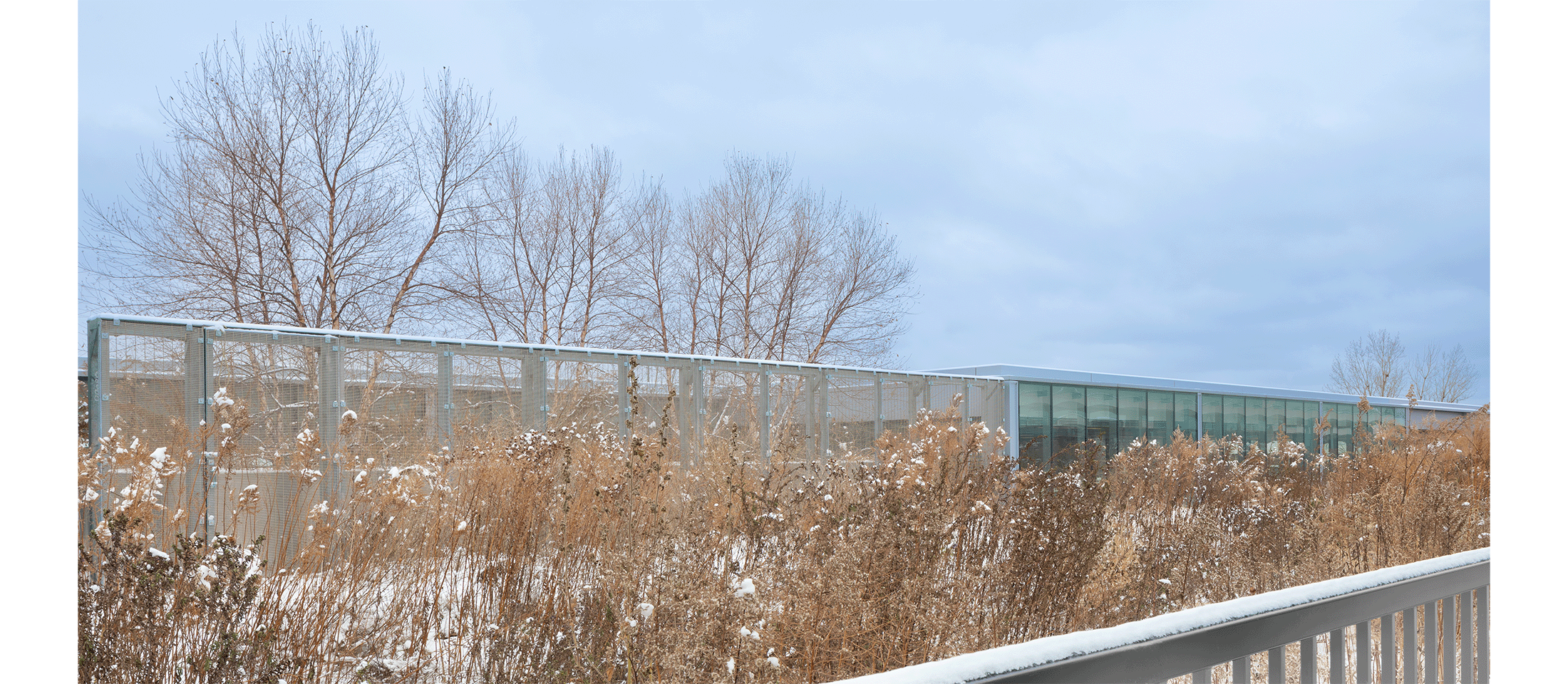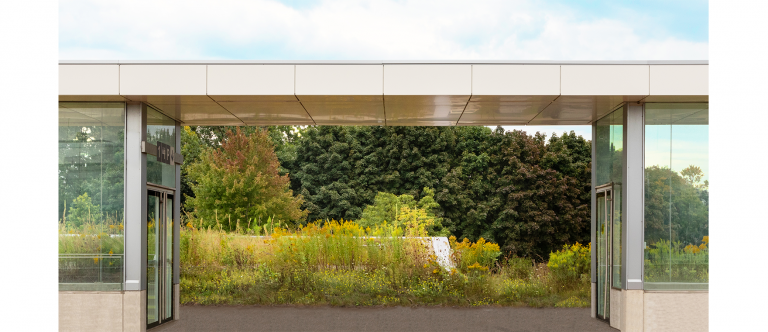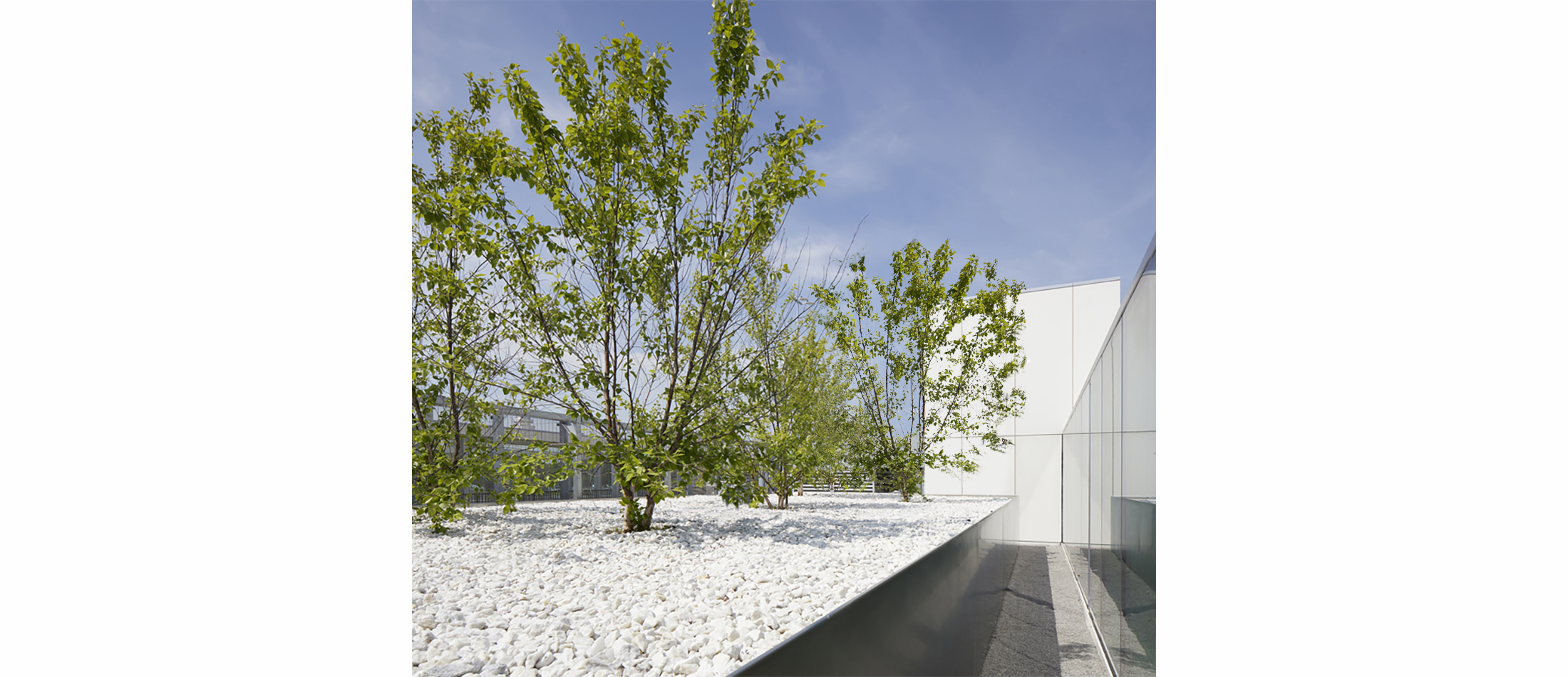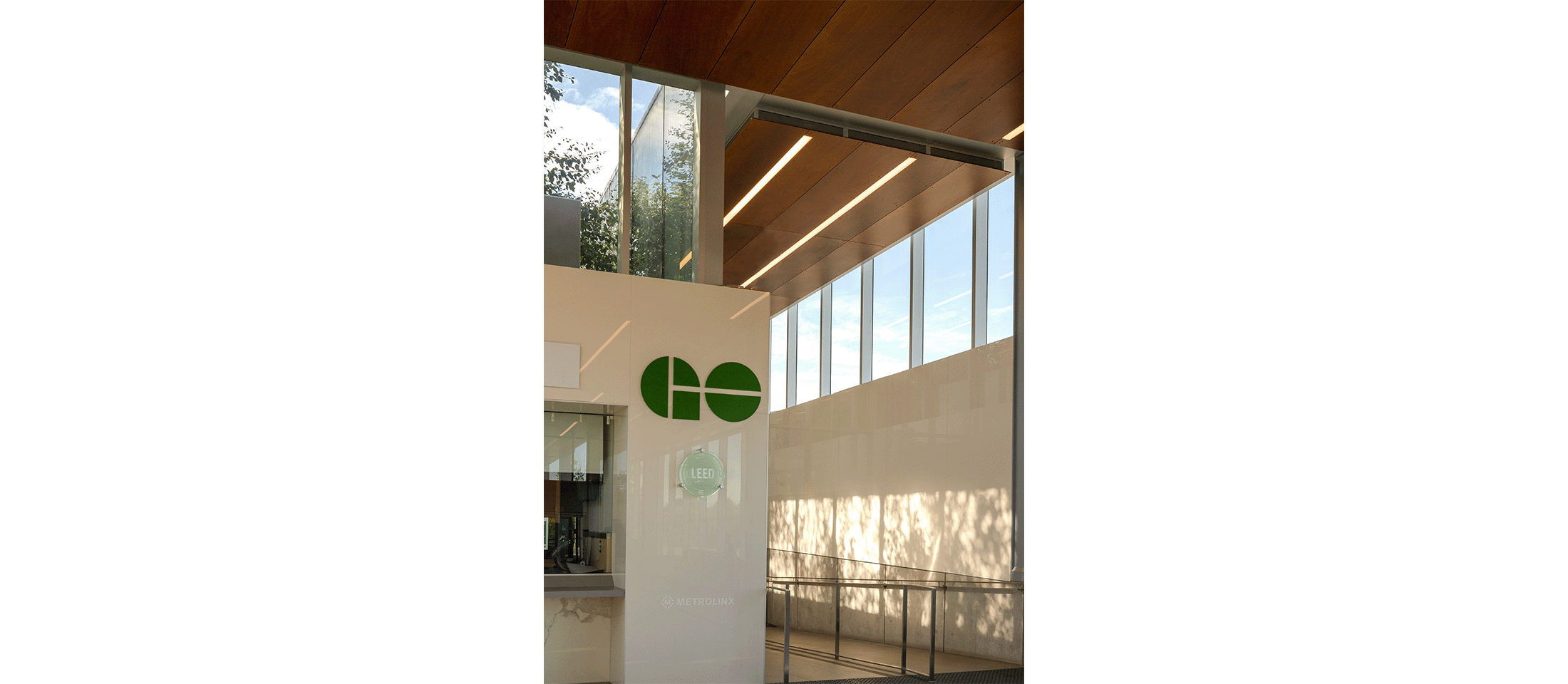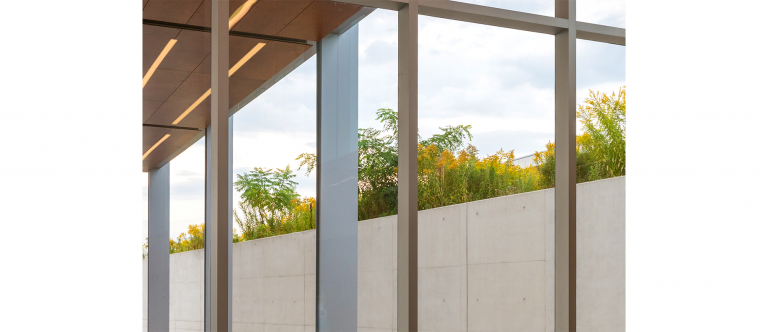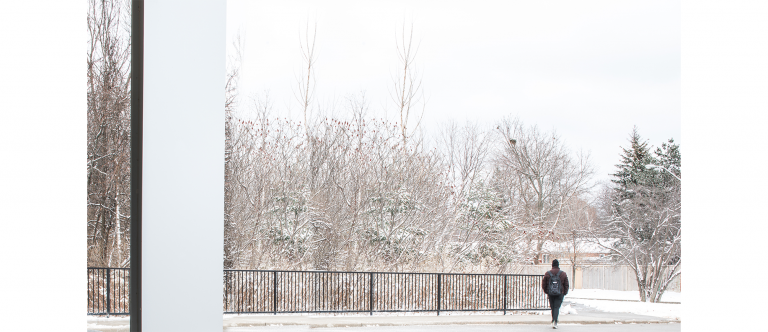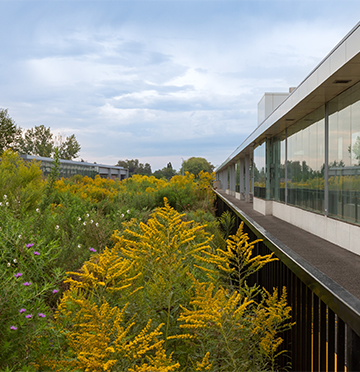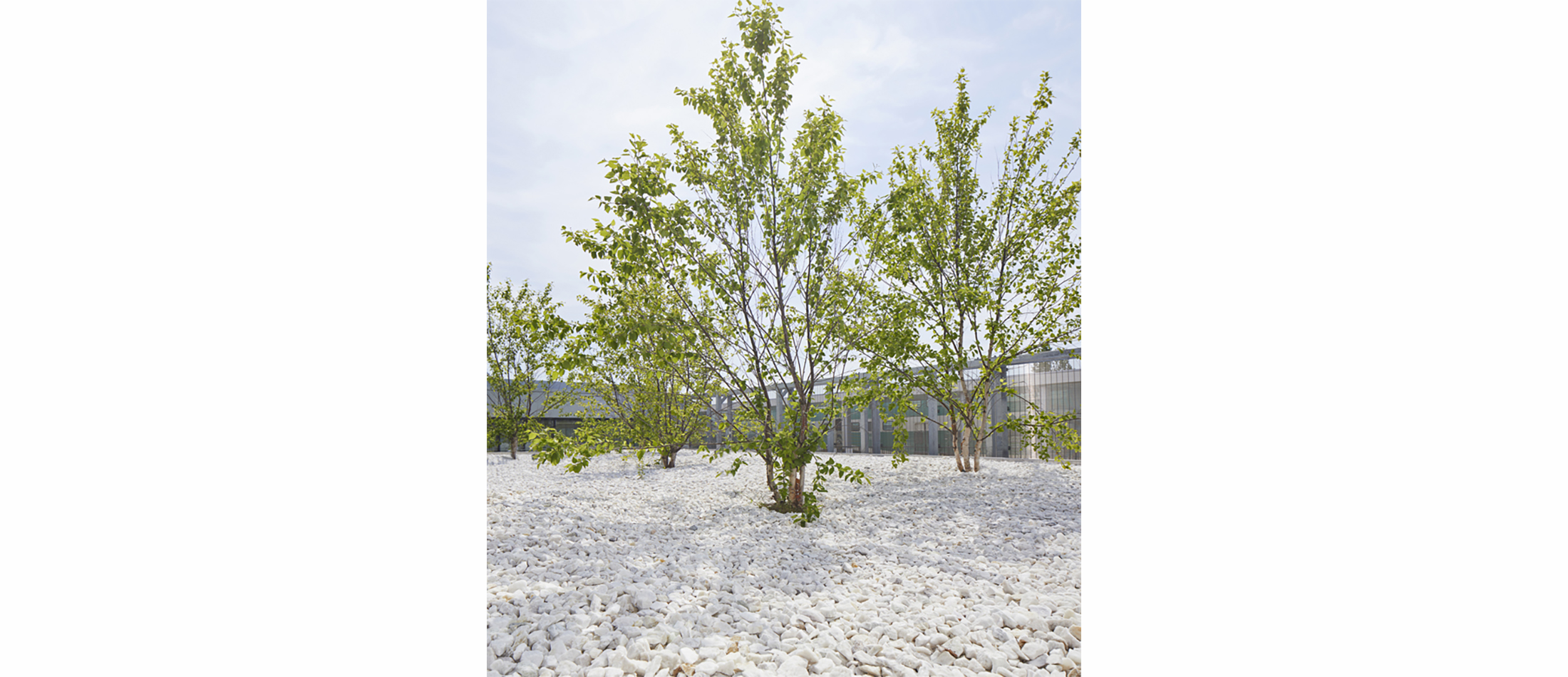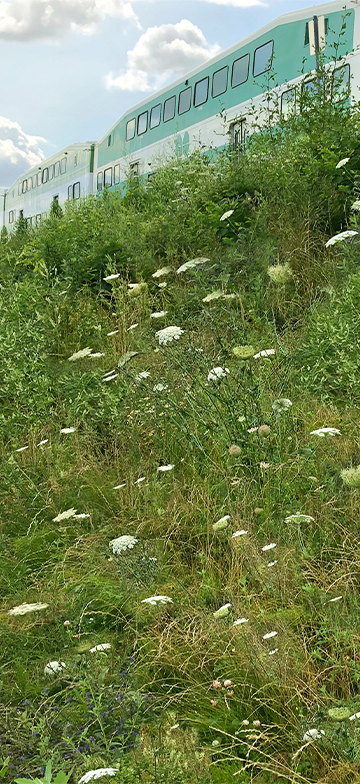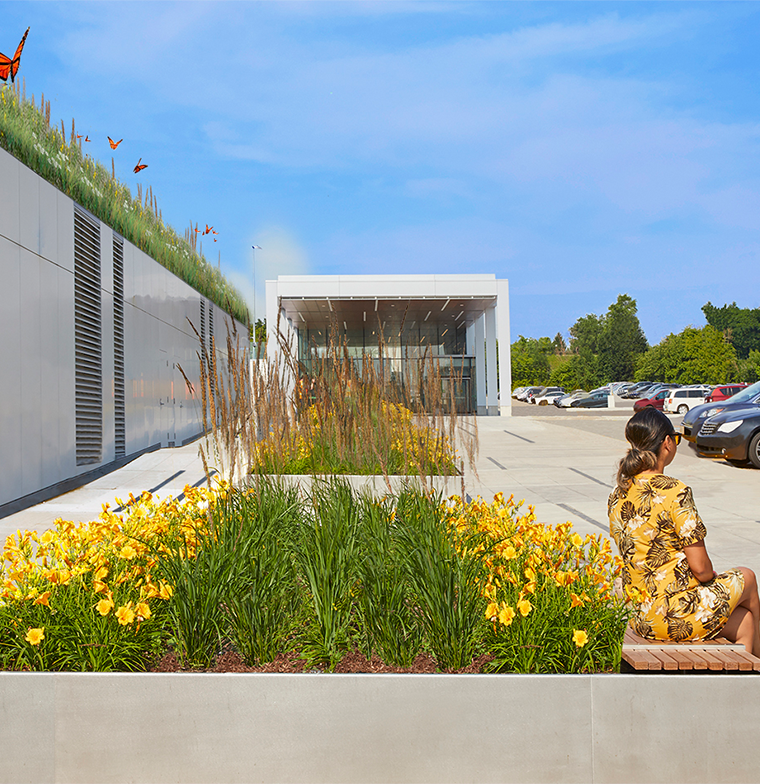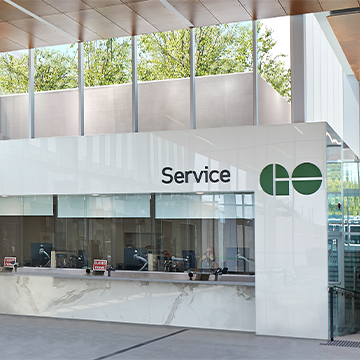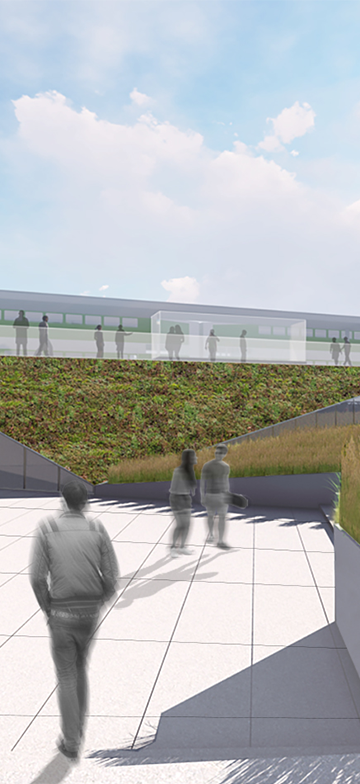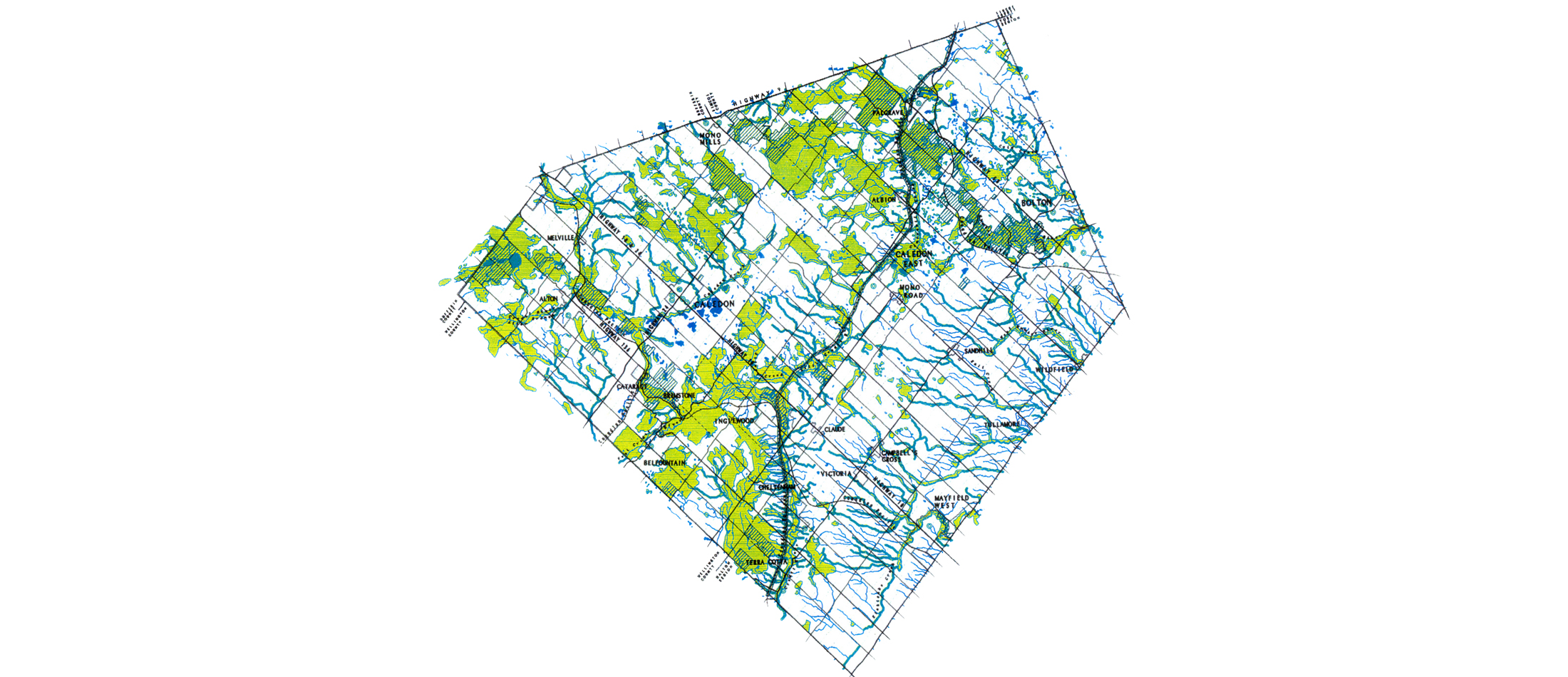+ Green Infrastructure + Urban Ecology
Eglinton GO Station
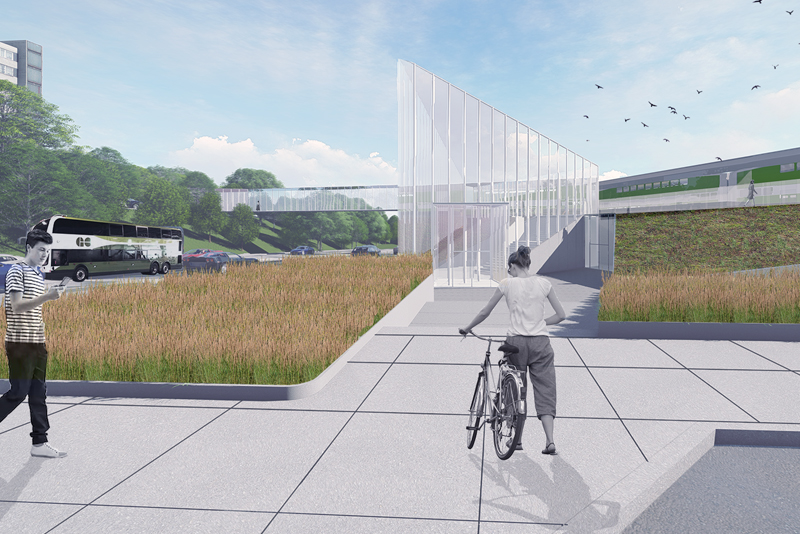
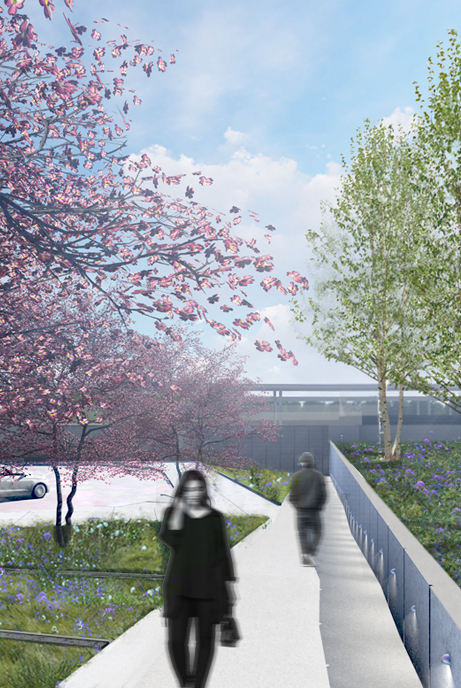
+ SUNKEN PLAZA
Elias + has worked on three separate GO Stations and each time the firm has taken a different approach to the design concept. It is based on the design principals that each project addresses design excellence, different site conditions, programmatic elements, client concerns and climate change. In addition, all materials are chosen for sustainability and resilience to salt and intensive pedestrian and vehicular use, with consideration for long term operating and maintenance costs. These principals answer in detail the following challenges. Can landscape, infrastructure and built form encourage the use of public transit in an automobile centric society? How do we interweave pedestrian, cycling, vehicular and rail modes of transportation to encourage this use? Eglinton GO Station is a unique project in that the topography of the surrounding roads, the climate of the extremely exposed urban context and the limited physical space for the new GO Station presented many challenges. In an effort to accommodate these site conditions, a triangular building was designed to fit into the tight area; the entry plaza is sunken into a sculptural and dynamic courtyard-like place that surrounds the commuter with lushly vegetated terraced concrete planters and a green roof. These elements form edges that shelter the commuter from harsh windy conditions. In the vehicular Kiss N` Ride zone, a large bike parking area is integrated into planting terraces to promote bike use. Concrete and granite benches are placed strategically under overhangs in protected walled areas alongside the Kiss n` Ride. A visually pleasing ornamental fence is designed to provide safety and reflect the minimal contemporary architecture of the building. It extends throughout the site, including south of the tracks, further connecting the building and terraced planters to each other and the landscape. On the south side of the tracks, large landscaped areas, mimicking the linearity of the tracks, break up the hardscape and liven up the south parking lot. All of the plants are chosen to enhance and reinforce the industrial character of the site. As a LEED driven project, two green roofs are integrated into the new station building and one utility building. As well, a proposed future pedestrian bridge across Eglinton Avenue, to connect the north parking lot with the new station, includes a green roof. All of the plants chosen for the site are salt tolerant, native, require minimal amounts of water, are low maintenance and provide seasonal interest.
Award – Canadian Architect Award of Excellence (2015)
+ Green Infrastructure + Urban Ecology
Guildwood GO Station
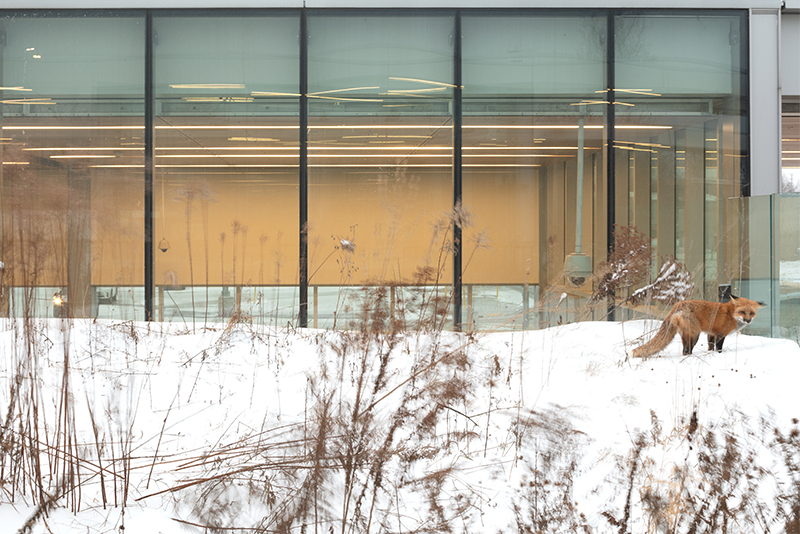
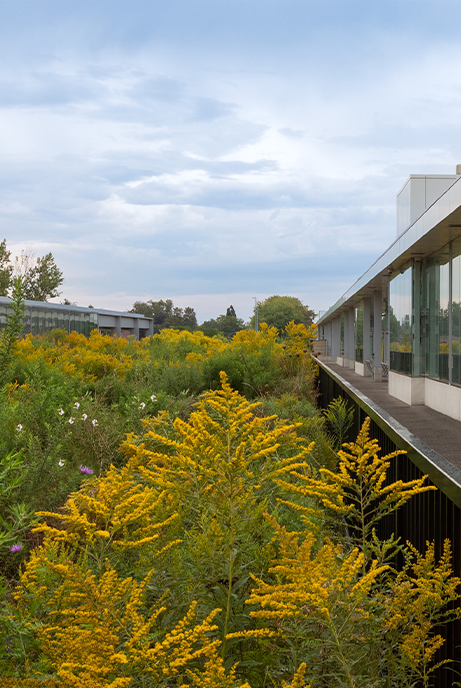
+ ECOLOGICAL SUCCESSION
The Site
Guildwood GO Station, located in Toronto, Canada, intertwines with the city’s ravine system. It is an innovative project, the first station to integrate green roofs with architecture and ravine ecosystems. Our team used an urban ecology approach as an intervention on the embankment slopes, green roofs, and roof courtyard.
Urban Ecology
Ecological succession is a biotic self-generating ecosystem that evolves from meadow to deciduous climax forest over a hundred-year period.
Concept
Embracing architecture and ecological succession enabled us to envision the landscape as a BRIDGE for human and non-human community movement and a GREEN OASIS amid an industrial corridor.
Track embankments create a linear topography echoed in the architecture. The geometry and materiality are repeated in the landscape through linear hedges, grasses, 18-meter-long stainless steel and Ipe wood seating planters. Granite strips embedded in the concrete plaza continue the lighting/flooring pattern of the interior and canopy. The green roofs and roof courtyard integrate vertically with the architecture.
The Experience
Inside views to the green roofs and roof courtyard at every point of commuter movement further establish an architectural connection with the landscape. Upon exiting the tunnels, commuters are greeted with panoramic views of borrowed landscapes merging into the roof meadows and slopes on both north and south platforms. The landscape atmospherically changes each season, from spring’s vibrant green to the warm colours of summer and fall to the whites of winter.
Ecological succession, a design intervention, has the potential to influence related design disciplines and engage the public. At Guildwood GO Station, with its unique mix of inviting architecture, ecological succession and traditional landscape aesthetics, commuters can once again engage with nature.
Award – Architizer A+ Awards – Sustainable Transportation Finalist (2024)
Award – Green Roof and Wall Award of Excellence – Special Recognition (2023)
Award – Architizer A+Awards – Architecture + Landscape Finalist (2023)
Award – Toronto Urban Design Award (2021)
Award – Ontario Concrete Award (2019)
Award – Infrastructure Award Best of Year for Innovation and Excellence (2019)
+ Green Infrastructure + Urban Ecology
Guildwood GO Station


+ ECOLOGICAL SUCCESSION
The Site
Guildwood GO Station, located in Toronto, Canada, intertwines with the city’s ravine system. It is an innovative project, the first station to integrate green roofs with architecture and ravine ecosystems. Our team used an urban ecology approach as an intervention on the embankment slopes, green roofs, and roof courtyard.
Urban Ecology
Ecological succession is a biotic self-generating ecosystem that evolves from meadow to deciduous climax forest over a hundred-year period.
Concept
Embracing architecture and ecological succession enabled us to envision the landscape as a BRIDGE for human and non-human community movement and a GREEN OASIS amid an industrial corridor.
Track embankments create a linear topography echoed in the architecture. The geometry and materiality are repeated in the landscape through linear hedges, grasses, 18-meter-long stainless steel and Ipe wood seating planters. Granite strips embedded in the concrete plaza continue the lighting/flooring pattern of the interior and canopy. The green roofs and roof courtyard integrate vertically with the architecture.
The Experience
Inside views to the green roofs and roof courtyard at every point of commuter movement further establish an architectural connection with the landscape. Upon exiting the tunnels, commuters are greeted with panoramic views of borrowed landscapes merging into the roof meadows and slopes on both north and south platforms. The landscape atmospherically changes each season, from spring’s vibrant green to the warm colours of summer and fall to the whites of winter.
Ecological succession, a design intervention, has the potential to influence related design disciplines and engage the public. At Guildwood GO Station, with its unique mix of inviting architecture, ecological succession and traditional landscape aesthetics, commuters can once again engage with nature.
Award – Architizer A+ Awards – Sustainable Transportation Finalist (2024)
Award – Green Roof and Wall Award of Excellence – Special Recognition (2023)
Award – Architizer A+Awards – Architecture + Landscape Finalist (2023)
Award – Toronto Urban Design Award (2021)
Award – Ontario Concrete Award (2019)
Award – Infrastructure Award Best of Year for Innovation and Excellence (2019)
+ Green Infrastructure + Urban Ecology
Eglinton Go Station


+ SUNKEN PLAZA
Elias + has worked on three separate GO Stations and each time the firm has taken a different approach to the design concept. It is based on the design principals that each project addresses design excellence, different site conditions, programmatic elements, client concerns and climate change. In addition, all materials are chosen for sustainability and resilience to salt and intensive pedestrian and vehicular use, with consideration for long term operating and maintenance costs. These principals answer in detail the following challenges. Can landscape, infrastructure and built form encourage the use of public transit in an automobile centric society? How do we interweave pedestrian, cycling, vehicular and rail modes of transportation to encourage this use? Eglinton GO Station is a unique project in that the topography of the surrounding roads, the climate of the extremely exposed urban context and the limited physical space for the new GO Station presented many challenges. In an effort to accommodate these site conditions, a triangular building was designed to fit into the tight area; the entry plaza is sunken into a sculptural and dynamic courtyard-like place that surrounds the commuter with lushly vegetated terraced concrete planters and a green roof. These elements form edges that shelter the commuter from harsh windy conditions. In the vehicular Kiss N` Ride zone, a large bike parking area is integrated into planting terraces to promote bike use. Concrete and granite benches are placed strategically under overhangs in protected walled areas alongside the Kiss n` Ride. A visually pleasing ornamental fence is designed to provide safety and reflect the minimal contemporary architecture of the building. It extends throughout the site, including south of the tracks, further connecting the building and terraced planters to each other and the landscape. On the south side of the tracks, large landscaped areas, mimicking the linearity of the tracks, break up the hardscape and liven up the south parking lot. All of the plants are chosen to enhance and reinforce the industrial character of the site. As a LEED driven project, two green roofs are integrated into the new station building and one utility building. As well, a proposed future pedestrian bridge across Eglinton Avenue, to connect the north parking lot with the new station, includes a green roof. All of the plants chosen for the site are salt tolerant, native, require minimal amounts of water, are low maintenance and provide seasonal interest. Award – Canadian Architect Award of Excellence (2015)
+ Green Infrastructure + Urban Ecology
Eglinton Go Station


+ SUNKEN PLAZA
Elias + has worked on three separate GO Stations and each time the firm has taken a different approach to the design concept. It is based on the design principals that each project addresses design excellence, different site conditions, programmatic elements, client concerns and climate change. In addition, all materials are chosen for sustainability and resilience to salt and intensive pedestrian and vehicular use, with consideration for long term operating and maintenance costs. These principals answer in detail the following challenges. Can landscape, infrastructure and built form encourage the use of public transit in an automobile centric society? How do we interweave pedestrian, cycling, vehicular and rail modes of transportation to encourage this use? Eglinton GO Station is a unique project in that the topography of the surrounding roads, the climate of the extremely exposed urban context and the limited physical space for the new GO Station presented many challenges. In an effort to accommodate these site conditions, a triangular building was designed to fit into the tight area; the entry plaza is sunken into a sculptural and dynamic courtyard-like place that surrounds the commuter with lushly vegetated terraced concrete planters and a green roof. These elements form edges that shelter the commuter from harsh windy conditions. In the vehicular Kiss N` Ride zone, a large bike parking area is integrated into planting terraces to promote bike use. Concrete and granite benches are placed strategically under overhangs in protected walled areas alongside the Kiss n` Ride. A visually pleasing ornamental fence is designed to provide safety and reflect the minimal contemporary architecture of the building. It extends throughout the site, including south of the tracks, further connecting the building and terraced planters to each other and the landscape. On the south side of the tracks, large landscaped areas, mimicking the linearity of the tracks, break up the hardscape and liven up the south parking lot. All of the plants are chosen to enhance and reinforce the industrial character of the site. As a LEED driven project, two green roofs are integrated into the new station building and one utility building. As well, a proposed future pedestrian bridge across Eglinton Avenue, to connect the north parking lot with the new station, includes a green roof. All of the plants chosen for the site are salt tolerant, native, require minimal amounts of water, are low maintenance and provide seasonal interest. Award – Canadian Architect Award of Excellence (2015)
+ Green Infrastructure + Urban Ecology
Eglinton Go Station


+ THE CHALLENGES
Elias + has worked on three separate GO Stations and each time the firm has taken a different approach to the design concept. It is based on the design principals that each project addresses design excellence, different site conditions, programmatic elements, client concerns and climate change. In addition, all materials are chosen for sustainability and resilience to salt and intensive pedestrian and vehicular use, with consideration for long term operating and maintenance costs. These principals answer in detail the following challenges. Can landscape, infrastructure and built form encourage the use of public transit in an automobile centric society? How do we interweave pedestrian, cycling, vehicular and rail modes of transportation to encourage this use? Eglinton GO Station is a unique project in that the topography of the surrounding roads, the climate of the extremely exposed urban context and the limited physical space for the new GO Station presented many challenges. In an effort to accommodate these site conditions, a triangular building was designed to fit into the tight area; the entry plaza is sunken into a sculptural and dynamic courtyard-like place that surrounds the commuter with lushly vegetated terraced concrete planters and a green roof. These elements form edges that shelter the commuter from harsh windy conditions. In the vehicular Kiss N` Ride zone, a large bike parking area is integrated into planting terraces to promote bike use. Concrete and granite benches are placed strategically under overhangs in protected walled areas alongside the Kiss n` Ride. A visually pleasing ornamental fence is designed to provide safety and reflect the minimal contemporary architecture of the building. It extends throughout the site, including south of the tracks, further connecting the building and terraced planters to each other and the landscape. On the south side of the tracks, large landscaped areas, mimicking the linearity of the tracks, break up the hardscape and liven up the south parking lot. All of the plants are chosen to enhance and reinforce the industrial character of the site. As a LEED driven project, two green roofs are integrated into the new station building and one utility building. As well, a proposed future pedestrian bridge across Eglinton Avenue, to connect the north parking lot with the new station, includes a green roof. All of the plants chosen for the site are salt tolerant, native, require minimal amounts of water, are low maintenance and provide seasonal interest. Award – Canadian Architect Award of Excellence (2015)
+ Green Infrastructure + Urban Ecology
Guildwood GO Station


+ GREEN CORRIDOR
The Site
Guildwood GO Station, located in Toronto, Canada, intertwines with the city’s ravine system. It is an innovative project, the first station to integrate green roofs with architecture and ravine ecosystems. Our team used an urban ecology approach as an intervention on the embankment slopes, green roofs, and roof courtyard.
Urban Ecology
Ecological succession is a biotic self-generating ecosystem that evolves from meadow to deciduous climax forest over a hundred-year period.
Concept
Embracing architecture and ecological succession enabled us to envision the landscape as a BRIDGE for human and non-human community movement and a GREEN OASIS amid an industrial corridor.
Track embankments create a linear topography echoed in the architecture. The geometry and materiality are repeated in the landscape through linear hedges, grasses, 18-meter-long stainless steel and Ipe wood seating planters. Granite strips embedded in the concrete plaza continue the lighting/flooring pattern of the interior and canopy. The green roofs and roof courtyard integrate vertically with the architecture.
The Experience
Inside views to the green roofs and roof courtyard at every point of commuter movement further establish an architectural connection with the landscape. Upon exiting the tunnels, commuters are greeted with panoramic views of borrowed landscapes merging into the roof meadows and slopes on both north and south platforms. The landscape atmospherically changes each season, from spring’s vibrant green to the warm colours of summer and fall to the whites of winter.
Ecological succession, a design intervention, has the potential to influence related design disciplines and engage the public. At Guildwood GO Station, with its unique mix of inviting architecture, ecological succession and traditional landscape aesthetics, commuters can once again engage with nature.
Award – Green Roof and Wall Award of Excellence – Special Recognition (2023)
Award – Architizer A+Awards – Architecture +Landscape (2023)
Award – Ontario Concrete Award (2019)
Award – Infrastructure Award Best of Year for Innovation and Excellence (2019)
Award – Toronto Urban Design Award (2021)
+ Green Infrastructure + Urban Ecology
Guildwood GO Station


+ GREEN CORRIDOR
The Site
Guildwood GO Station, located in Toronto, Canada, intertwines with the city’s ravine system. It is an innovative project, the first station to integrate green roofs with architecture and ravine ecosystems. Our team used an urban ecology approach as an intervention on the embankment slopes, green roofs, and roof courtyard.
Urban Ecology
Ecological succession is a biotic self-generating ecosystem that evolves from meadow to deciduous climax forest over a hundred-year period.
Concept
Embracing architecture and ecological succession enabled us to envision the landscape as a BRIDGE for human and non-human community movement and a GREEN OASIS amid an industrial corridor.
Track embankments create a linear topography echoed in the architecture. The geometry and materiality are repeated in the landscape through linear hedges, grasses, 18-meter-long stainless steel and Ipe wood seating planters. Granite strips embedded in the concrete plaza continue the lighting/flooring pattern of the interior and canopy. The green roofs and roof courtyard integrate vertically with the architecture.
The Experience
Inside views to the green roofs and roof courtyard at every point of commuter movement further establish an architectural connection with the landscape. Upon exiting the tunnels, commuters are greeted with panoramic views of borrowed landscapes merging into the roof meadows and slopes on both north and south platforms. The landscape atmospherically changes each season, from spring’s vibrant green to the warm colours of summer and fall to the whites of winter.
Ecological succession, a design intervention, has the potential to influence related design disciplines and engage the public. At Guildwood GO Station, with its unique mix of inviting architecture, ecological succession and traditional landscape aesthetics, commuters can once again engage with nature.
Award – Green Roof and Wall Award of Excellence – Special Recognition (2023)
Award – Architizer A+Awards – Architecture +Landscape (2023)
Award – Ontario Concrete Award (2019)
Award – Infrastructure Award Best of Year for Innovation and Excellence (2019)
Award – Toronto Urban Design Award (2021)
+ Green Infrastructure + Urban Ecology
Guildwood GO Station


+ GREEN CORRIDOR
The Site
Guildwood GO Station, located in Toronto, Canada, intertwines with the city’s ravine system. It is an innovative project, the first station to integrate green roofs with architecture and ravine ecosystems. Our team used an urban ecology approach as an intervention on the embankment slopes, green roofs, and roof courtyard.
Urban Ecology
Ecological succession is a biotic self-generating ecosystem that evolves from meadow to deciduous climax forest over a hundred-year period.
Concept
Embracing architecture and ecological succession enabled us to envision the landscape as a BRIDGE for human and non-human community movement and a GREEN OASIS amid an industrial corridor.
Track embankments create a linear topography echoed in the architecture. The geometry and materiality are repeated in the landscape through linear hedges, grasses, 18-meter-long stainless steel and Ipe wood seating planters. Granite strips embedded in the concrete plaza continue the lighting/flooring pattern of the interior and canopy. The green roofs and roof courtyard integrate vertically with the architecture.
The Experience
Inside views to the green roofs and roof courtyard at every point of commuter movement further establish an architectural connection with the landscape. Upon exiting the tunnels, commuters are greeted with panoramic views of borrowed landscapes merging into the roof meadows and slopes on both north and south platforms. The landscape atmospherically changes each season, from spring’s vibrant green to the warm colours of summer and fall to the whites of winter.
Ecological succession, a design intervention, has the potential to influence related design disciplines and engage the public. At Guildwood GO Station, with its unique mix of inviting architecture, ecological succession and traditional landscape aesthetics, commuters can once again engage with nature.
Award – Green Roof and Wall Award of Excellence – Special Recognition (2023)
Award – Architizer A+Awards – Architecture +Landscape (2023)
Award – Ontario Concrete Award (2019)
Award – Infrastructure Award Best of Year for Innovation and Excellence (2019)
Award – Toronto Urban Design Award (2021)
+ Green Infrastructure + Urban Ecology
Town of Caledon
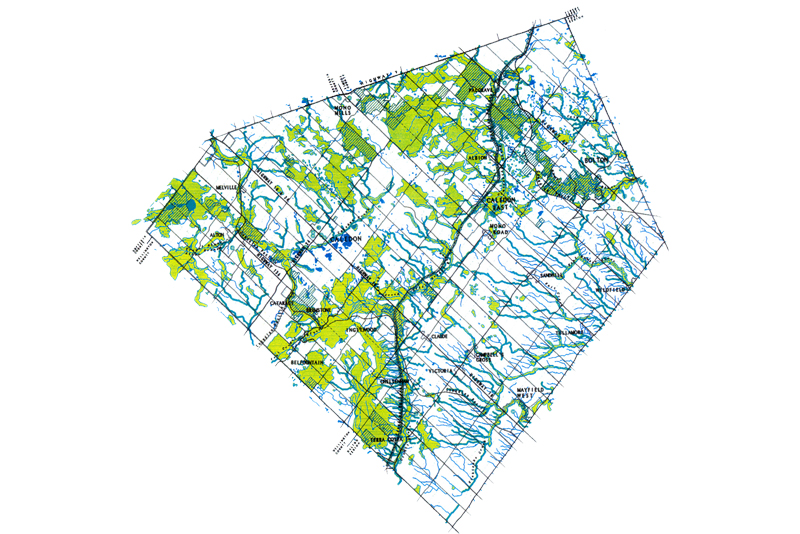

+ ECOSYSTEM TOWN PLAN
The Town of Caledon was in the process of reviewing its Official Plan policies pertaining to environmental protection and heritage conservation. Stage 1 of the Review work study program included the completion of two background studies: this Environmental Background Study; and a Cultural Heritage Background Study. The purpose of the Environmental Background Study and the Ecosystem Planning Goals, were to recommend a framework for an ecosystem based masterplan. The computerized (GIS Systems) utilized for this study, revealed a natural environment in the Town of Caledon which is both extensive and unique. The sustained health and integrity of this natural environment contributes to the maintenance of air quality, surface and sub-surface water quality and quantity, biological diversity and quality of life. This ecosystem plan would ensure the long term, sustained health and integrity of the town’s natural systems and provide Caledon’s communities with a meaningful, ongoing participation, in the environmental planning, management and decision making process.

